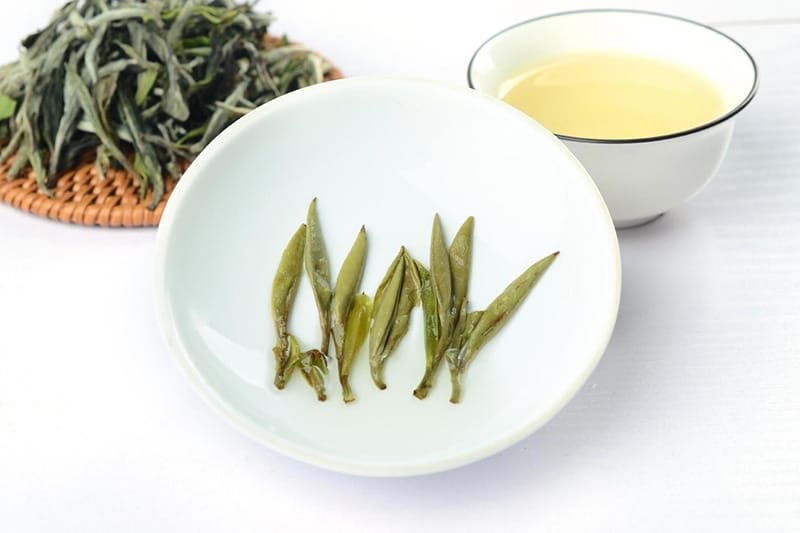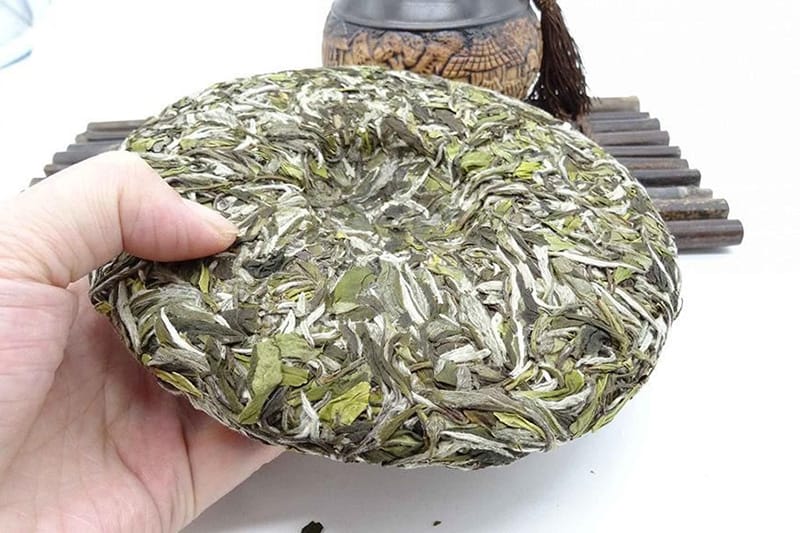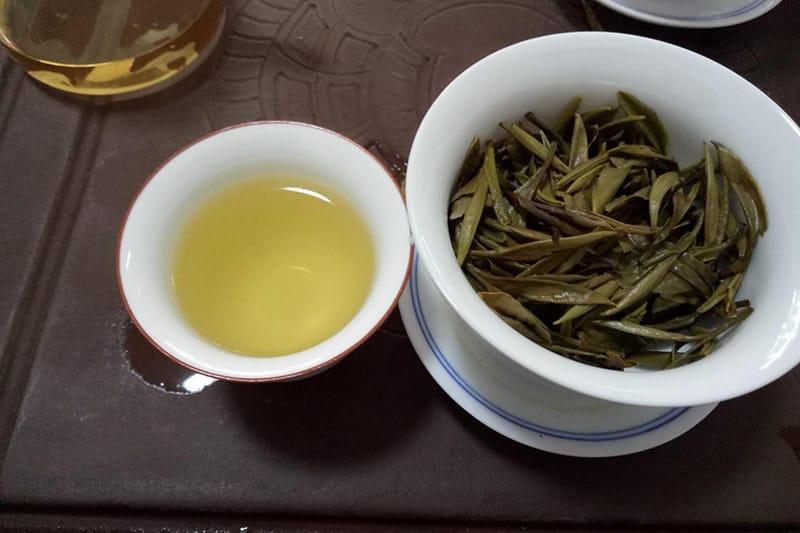Last Updated on 02/07/2022 by Desmond
White peony is a flower name, but to tea lovers, that it’s a kind of awesome tea. Don’t be misunderstood, it’s not a herbal tea but a type of white tea from China. Due to the least processing, people thought it could bring more natural benefits than green tea, becoming more and more popular in recent years. And the white peony tea(Bai Mu Dan) may be the one with the best cost-effective.
CONTENT
What Is White Peony Tea
Except for the moonlight white tea, in the traditional sense, the authentic white teas are graded into 3 classes by the picking standard:
- Baihao Yinzhen(Silver Needle Tea) – Only made from the tenderest buds;
- White Peony Tea – Made from one bud and the first or the second leaf;
- Shoumei Tea(Gongmei) – Made from one bud and the forth or the fifth leaf;
Generally recognized that the white peony tea quality is second to the silver needle but higher than Shoumei. Even though their price reflects this situation, they are actually teas with a totally different flavor. It seems not right to judge their quality only by the picking standard.
White peony tea originated in Fujian, also called Bai Mu Dan. Fuding and Zhenghe are both famous producing regions. The source leaves are picked from the Da Bai or narcissus type Camellia Sinensis, the feature is full of tiny fuzz(Hao) on the leaves. The flavor also has a little difference between Fuding and Zhenghe white peony tea because of the different cultivating environments.
Every year when the spring comes, the Fujian tea farmers are beginning to get busy picking tea. At this time, the tender buds are growing on the branches, which is for making Baihao Yinzhen tea. Plants growing fast in spring, tea farmers need to finish the picking job in about 10 days, before the buds develop into leaves.
When the Qingming(A Chinese Solar Term, 4th April) Comes, the first bud grows into the first leaf, and the new bud will branching out. Farmers pick them both for making into white peony tea. The time for picking white peony tea is also short. It will typically be finished before the Guyu(A Chinese Solar Term, 20th April) comes. The leaves coming later only can be made into Shoumei tea. It makes both silver needle and white peony tea a low yield and leads to a high price.
Unlike silver needle tea, which only got the white-fuzz buds, white peony tea still with 1 or 2 leaves more. The tea will spread out when brewing and looks like a white flower in the water; that’s how the name comes. Personally, I think the tea may be named by the tea master casually because you are hard to connect the tea look and the white peony flower.
In Chinese culture, peony emblems luck, elegant, and rich, and it’s the Chinese national flower. But many of the time, people refer to the pink peony but not the white one, because of white emblems death in Chinese culture. So named the tea as white peony is unlikely for a good omen reason.
Processing Methods
White tea got the least processing degree in all tea types, only a simple withering, and drying. It makes white tea leaves retained the most original style and look like fallen-leaves.
Withering refers to let the water in leaves getting evaporate by a placing way and being a certain fermenting degree. Traditionally, white tea will be withered in a sun-drying way. With the cultivation and production scale growing, the Fujian tea master now prefers to wither the leaves in an indoor way.
After picking, the leaves will be placed on a giant bamboo sieve, then sent into the withering workshop. The temperature in the house will be controlled at about 22-27℃ and 67%-75% humidity. It cost about 25-30 hours till the leaves’ water content is reduced to under 25%. Compared with sun-drying, indoor-withering can make the fermented degree better controlled and not affected by the weather factor, leading to a higher yield.
Finally, the tea masters will dry the leaves with a machine to let the water content further reduced to under 7%-8.5% (many of the time, it will be lower.) Just like Shoumei tea, white peony tea often will be steam to soft and compressing into tea cakes for sale; it can also get a new flavor after long-time aging. Some creative tea masters will compress the white peony tea into a small ball(dragon balls), which is very convenient for just one brew.
White Peony Tea Grades
White peony tea will be classified into 4 grades according to the picking standard and leaves quality.
Peony King
Peony King’s flavor is close to Baihao Yinzhen because it is mainly made from one bud with the first leaf; the second leaf is in less situation. The buds are fat and big, with more fuzz than the leaves. So when you are making a cup of peony king tea, more flavor comes from the “Hao aroma,” and the mouthfeel also mild and smooth.
First-Grade White Peony
The first-grade white peony tea is made from one bud with the first and the second leaf. The bud is long and thick, also full of white fuzz. And the leaves are narrow, and fuzz is on the back. The leaves are more than buds, so the first-grade white peony tea has a stronger floral aroma and a little wild grass smell.
Second-Grade White Peony
The bud of the second-grade white peony tea is much smaller, and the leaves are bigger. It will get some stems because the leaves had grown when picking. Even though the second-grade one still with lots of fuzz, the floral aroma from the leaves almost concealed the Hao aroma. The tea stems also bring some herbs scent; it will be more obvious after rounds brewing.
Third-Grade White Peony
The third-grade white peony was the last picked, one bud with two leaves; some buds have grown into the third leaf. Because the proportion of leaves and stems is bigger, the third-grade white peony tea tastes close to the Shoumei tea, with a strong floral and herbs aroma. And after aging, it will be easier to develop the TCM scent.
White Peony Tea Benefits
Due to the least processing, the white tea beneficial ingredients are more close to the natural state. This is very consistent with the modern health concept of advocating a natural diet, even though the benefits it brings actually will not be much more than the other teas.
Compared with Baihao Yinzhen, white peony tea not only got the tender bud but leaves, so rich beneficial ingredients it contains. Especially the tea polysaccharide that contains in stems.
Likewise, white peony tea benefits come from tea polyphenols, which are richer in the tenderer buds and leaves. Having white peony tea is good for:
Anti-inflammatory
Tea polyphenol is an efficient natural anti-inflammatory. It can help eliminate inflammation in the body, prevent any related diseases like CVD; to a certain extent, it can also help prevent cancer. To the people who love beauty, they may be more focused on the skin-beauty effect. Many skincare products declared they have white tea extractive contained and good for the skin.
Anti-aged
As an antioxidant, tea polyphenol also can help with anti-aged, especially in preventing wrinkles.
Weight Loss
White peony tea not only rich in tea polyphenol but caffeine. Under their synergistic effect, it can help the body better manage fat absorption, reduce the fat accumulate, and lead to a weight loss purpose.
Liver Protection
Alcohol will harm the liver. A study showed that the antioxidant in white peony tea could help fix the impaired liver and reduce alcohol absorption. It seems a great help to the drunkards on their AA program.
Related Reading: What Is Tea Polyphenol & What Is It Good For.
Caffeine In White Peony Tea
White peony tea is made from the Camellia Sinensis, so it contains caffeine natively.
The caffeine amount in your cup is affected by many factors. Even though white peony tea is from the tenderest buds and leaves, it’s not the one that contains the most caffeine because of the processing and the brewing water temperature.
With moderate caffeine and rich amino acid, a cup of white peony tea can give you a vigorous morning or let the afternoon-weary go away. Of course, it still not suitable for drinking before bed, or it will cause insomnia by the caffeine stimulation.
Related Reading: Factors Influences Caffeine Amount In Tea.
How To Aging White Peony Tea
Just like dark tea, white peony tea also can get a better flavor by long-time storage. This change is not like the Pu-erh tea; more is from the internal material transform but not rely on the microorganism much.
The compressed tea cake will be more suitable for aging than loose leaves because the smaller surface area will not get damp by the water in the air easily. During the compress processing, the leaves will be a little break inevitably, a few chlorophylls lost, and get slightly fermented. So the white peony tea cake usually looks a darker green.
Before storing white peony tea, the first thing we should do is to check whether the leaves are damp. Take some leaves and pinch them with your fingers. If they break into a powder, that means they are dry enough; if they only are crimp but not broken, that means the teas may have already affected with damp and not suitable for aging.
Aging white peony tea does not need a ventilated air. We can package it with a non-smell aluminum foil seal bag, then put it in a cardboard box; it will be better to seal the box with tape after putting the tea in. The storing environment needs to be dark, air humidity under 45%, and the temperature should not higher than 25℃.
It’s not recommended to store the white tea in a fridge; the dried leaves are easily affected by the smell from other food, make the flavor go bad.
How To Make White Peony Tea
- Preheat and clean the teawares with 100℃ water;
- Take about 5g white peony tea, put them into a Gaiwan, cover, let the waste heat warm the leaves, and you will smell a charming scent when you open the lid after few seconds;
- Add 90℃ water in, cover, and steep for about 8 seconds, then pour out the infusion into a fair cup;
- Serving;
The white peony tea is full of tiny fuzz(Hao), which is the tea’s best value. So the first brewed you can drink directly; of course, you can short the steep time and pour it out as wastewater.
If you are making the aged white peony tea, after 3 rounds of brewing, you can transfer the leaves from the Gaiwan to a teapot. Add hot water in and keep heating to boil, then cook for about 3 minutes. Cooking can extract the aged white peony tea better.
Reference
Comparison of the main compounds in Fuding white tea infusions from various tea types;



